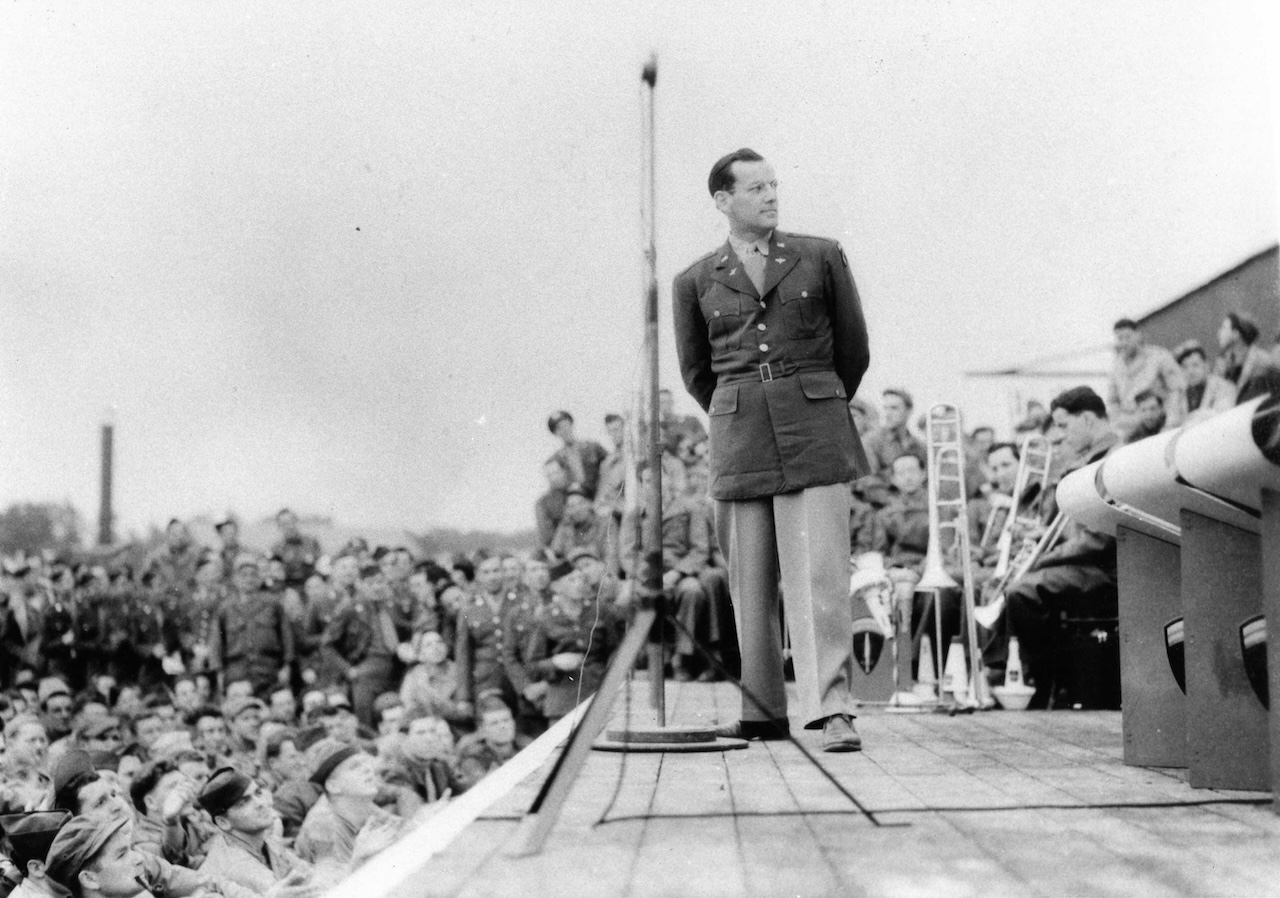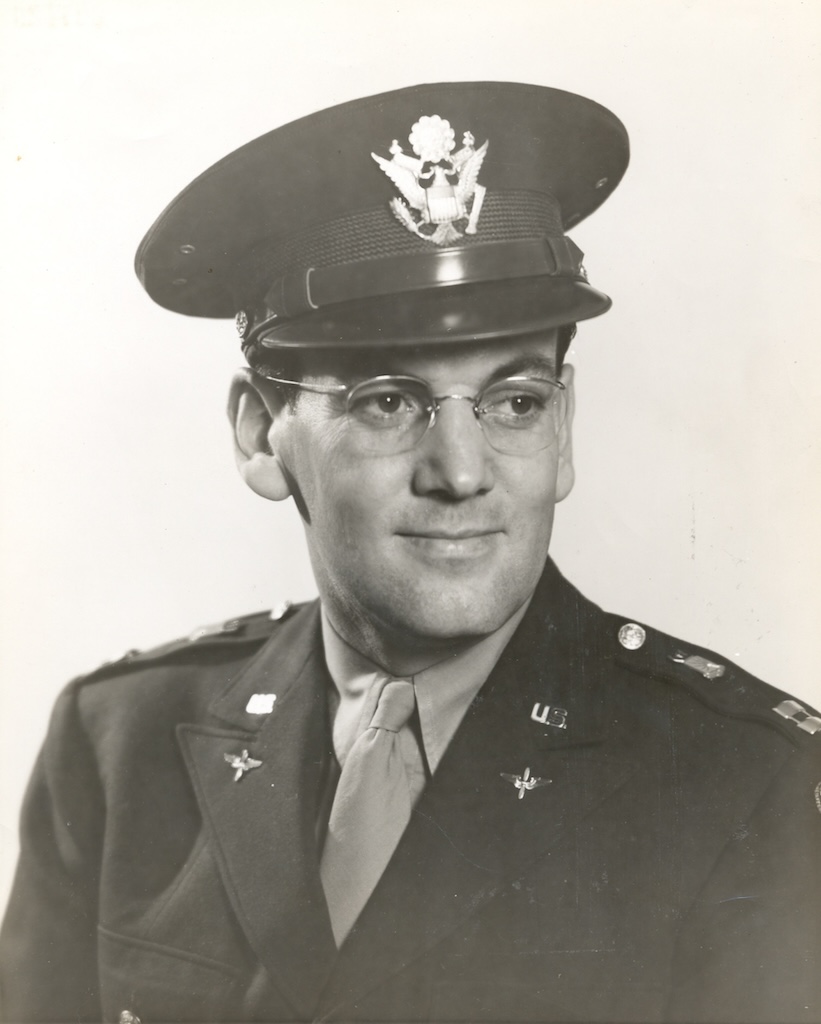
Glenn Miller onstage with the U.S. Army Air Forces Band (Special), Corn Exchange, Bedford, England, July 13, 1944. Photos courtesy of Glenn Miller Collections, University of Colorado Boulder
Nov/Dec 2024 (Volume 16, Issue 6)
Part 2 of 2
The pinnacle of America’s No. 1 bandleader
By Dennis M. Spragg
After achieving unmatched career success, Glenn Miller underwent a significant and unexpected career shift in 1942. With the United States now at war, Miller and the entertainment industry were tasked with providing stability and purpose to a fearful nation. As America’s top bandleader, he was a true patriot who genuinely cared for the young Americans who purchased his records, tuned in to his radio shows, and danced to his music at ballrooms nationwide.
Glenn Miller and His Orchestra were about to travel west and make a second motion picture for Twentieth Century-Fox Film Corporation, “Orchestra Wives,” which featured Jackie Gleason. Their unprecedented streak of No. 1 hits continued. On Feb. 10, 1942, RCA Victor-Bluebird Records presented Miller with the first “Gold Record” to commemorate “Chattanooga Choo Choo,” for sales of 1.2 million copies.
Before heading west, Miller met privately with U.S. military officials in March in Washington, D.C., to explore ways he might be of service, including the Army Specialist Corps (morale and recreation) and Special Services Radio Branch (soon to be the Armed Forces Radio Service). The Army Air Forces (AAF) had its own ambitious plan to operate radio and film units, and everyone promised to keep Miller in mind.
Glenn and Helen Miller moved into their new ranch in California, which Glenn had named “Tuxedo Junction.” RCA moved Miller from its Bluebird label to its Victor label. But the winds of change were upon the entertainment industry. Travel was curtailed, musicians were being drafted, and the American Federation of Musicians planned to strike the recording industry. Against this backdrop, Miller carefully considered his options. With a letter of recommendation from Bing Crosby, he applied for a commission in the U.S. Navy but was turned down. Turning to the U.S. Army, he was readily accepted.
On Sept. 10, 1942, Miller enlisted, announcing to a stunned public that “he felt a sense of duty.” On Sept. 24, in an emotional farewell “Chesterfield Moonlight Serenade” broadcast, Miller introduced his happy successor, Harry James.
On Sept. 27, Glenn Miller and his Orchestra performed their final concert in Passaic, N.J., and disappeared into history.
‘I Sustain the Wings’
Reporting for duty at Omaha on Oct. 7, Capt. Miller joined Army Specialist Corps officer training at Fort Meade, Md. Following the eight-week course, he received orders transferring him to the Army Air Forces and Maxwell Field, Ala. Following orientation, he was assigned on Jan. 1, 1943, to Knollwood Field, N.C., as the AAF Training Command Director of Bands, where he would become a vital asset in a highly coordinated and imaginative media strategy to inform the public, recruit young men and women, and fund the AAF.
Miller submitted a proposal to modernize AAF musical activities with a network of bands, including musicians from popular and classical backgrounds. Elite production units would staff network radio programs in New York and Hollywood. Miller had given up his fortune of earning about $20,000 per week from his civilian band to do this, and the AAF approved his vision. Miller soon organized the incoming musicians at the AAF Training Center in Atlantic City, N.J. He would personally lead the New York radio production unit, for which he selected the best available talent. Unlike his former band, this was a concert orchestra that could fuse jazz, popular and classical music as a complete entertainment unit.

A portrait of Capt. Glenn Miller, U.S. Army Air Forces, January 1943.
Stationed in March 1943 at the AAF Training School at Yale University in New Haven, Conn., Miller was about to accomplish things he could never have imagined as a civilian, receiving “carte blanche” authority from AAF Technical Training Command (TCC) commanding officer Gen. Barton Yount in Fort Worth, Texas. By June 1943, Miller’s radio production unit broadcast the network series “I Sustain the Wings” over CBS. In September, the program moved to NBC. The unit also recorded “Uncle Sam Presents” and “Music From America” for the Voice of America and other Armed Forces Radio Service and Treasury Department programs. They also made V-Disc recordings at RCA Victor studios for the U.S. War Department.
In New Haven, the band also handled base duties. Miller formed a marching band that famously played marching arrangements of jazz classics, including “St. Louis Blues” and “Blues in the Night,” causing angst among traditionalists. When told that the marches of John Philip Sousa were good enough for the last war, Miller sarcastically replied, “Tell me, are we still flying the same airplanes we flew in World War I?”
Unable to conceive naturally, Glenn and Helen Miller adopted a baby boy, Steven Davis Miller (1943-2012), to whom they poured out their unconditional love.
Many considered the Glenn Miller Army Air Forces Orchestra the most incredible Big Band that ever performed. But the ever-anxious Miller wanted to do more, stating, “I want to be there when the second front is open along with the men doing the fighting … I don’t want to play this war by remote control or on transcriptions.”
TO READ THE ENTIRE STORY AND OTHER FASCINATING STORIES ABOUT IOWA HISTORY, subscribe to Iowa History Journal.
